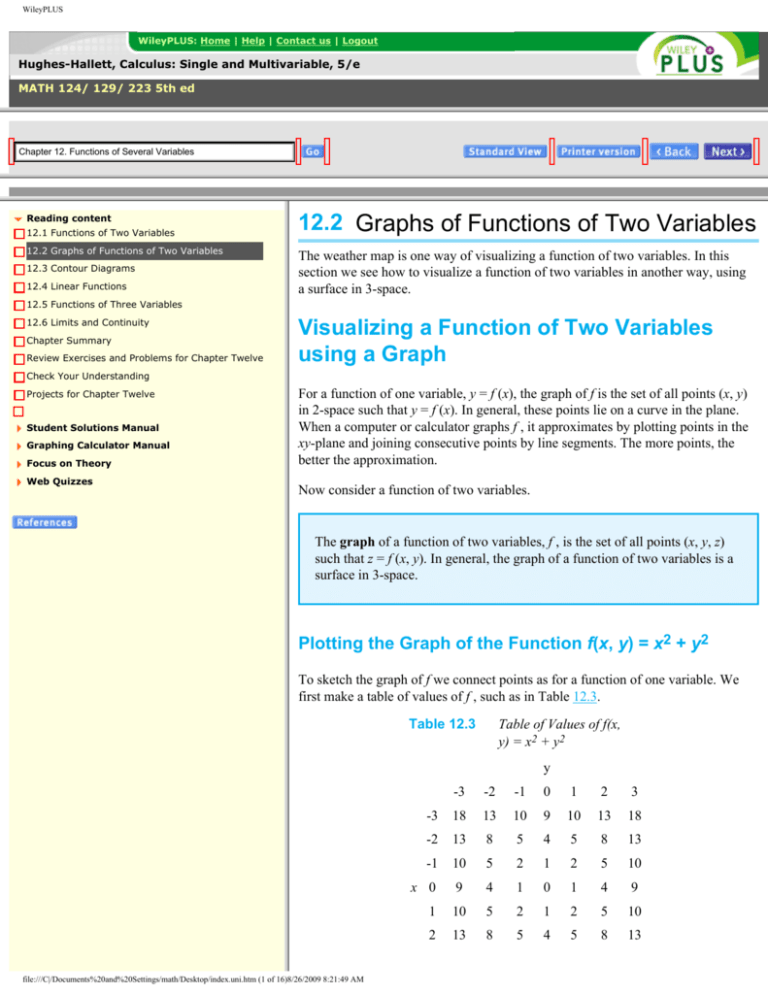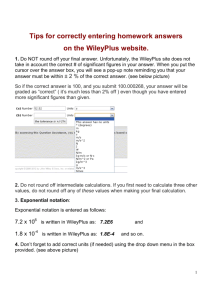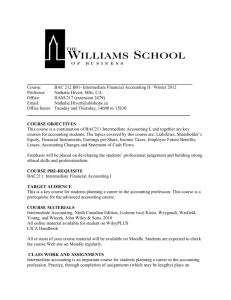
WileyPLUS
WileyPLUS: Home | Help | Contact us | Logout
Hughes-Hallett, Calculus: Single and Multivariable, 5/e
MATH 124/ 129/ 223 5th ed
Chapter 12. Functions of Several Variables
Reading content
12.1 Functions of Two Variables
12.2 Graphs of Functions of Two Variables
12.3 Contour Diagrams
12.4 Linear Functions
12.2 Graphs of Functions of Two Variables
The weather map is one way of visualizing a function of two variables. In this
section we see how to visualize a function of two variables in another way, using
a surface in 3-space.
12.5 Functions of Three Variables
12.6 Limits and Continuity
Chapter Summary
Review Exercises and Problems for Chapter Twelve
Visualizing a Function of Two Variables
using a Graph
Check Your Understanding
Projects for Chapter Twelve
Student Solutions Manual
Graphing Calculator Manual
Focus on Theory
Web Quizzes
For a function of one variable, y = f (x), the graph of f is the set of all points (x, y)
in 2-space such that y = f (x). In general, these points lie on a curve in the plane.
When a computer or calculator graphs f , it approximates by plotting points in the
xy-plane and joining consecutive points by line segments. The more points, the
better the approximation.
Now consider a function of two variables.
The graph of a function of two variables, f , is the set of all points (x, y, z)
such that z = f (x, y). In general, the graph of a function of two variables is a
surface in 3-space.
Plotting the Graph of the Function f(x, y) = x2 + y2
To sketch the graph of f we connect points as for a function of one variable. We
first make a table of values of f , such as in Table 12.3.
Table 12.3
Table of Values of f(x,
y) = x2 + y2
y
file:///C|/Documents%20and%20Settings/math/Desktop/index.uni.htm (1 of 16)8/26/2009 8:21:49 AM
-3
-2
-1
0
1
2
3
-3
18
13
10
9
10
13
18
-2
13
8
5
4
5
8
13
-1
10
5
2
1
2
5
10
x 0
9
4
1
0
1
4
9
1
10
5
2
1
2
5
10
2
13
8
5
4
5
8
13
WileyPLUS
3
18
13
10
9
10
13
18
Now we plot points. For example, we plot (1, 2, 5) because f (1, 2) = 5 and we
plot (0, 2, 4) because f (0, 2) = 4. Then, we connect the points corresponding to
the rows and columns in the table. The result is called a wire-frame picture of the
graph. Filling in between the wires gives a surface. That is the way a computer
drew the graphs in Figure 12.11 and 12.12. As more points are plotted, we get the
surface in Figure 12.13, called a paraboloid.
Figure 12.11 Wire frame picture of f (x, y) = x2 + y2 for -3 ≤ x ≤ 3,
-3 ≤ y ≤ 3
Figure 12.12 Wire frame picture of f (x, y) = x2 + y2 with more
points plotted
Figure 12.13 Graph of f (x, y) = x2 + y2 for -3 ≤ x ≤ 3, -3 ≤ y ≤ 3
You should check to see if the sketches make sense. Notice that the graph goes
through the origin since (x, y, z) = (0, 0, 0) satisfies z = x2 + y2. Observe that if x is
file:///C|/Documents%20and%20Settings/math/Desktop/index.uni.htm (2 of 16)8/26/2009 8:21:49 AM
WileyPLUS
held fixed and y is allowed to vary, the graph dips down and then goes back up,
just like the entries in the rows of Table 12.3. Similarly, if y is held fixed and x is
allowed to vary, the graph dips down and then goes back up, just like the columns
of Table 12.3.
New Graphs from Old
We can use the graph of a function to visualize the graphs of related functions.
Example 1
Let f (x, y) = x2 + y2. Describe in words the graphs of the following
functions:
(a) g(x, y) = x2 + y2 + 3,
(b) h(x, y) = 5 - x2 - y2,
(c) k(x, y) = x2 + (y - 1)2.
Solution
We know from Figure 12.13 that the graph of f is a paraboloid, or
bowl with its vertex at the origin. From this we can work out what
the graphs of g, h, and k will look like.
(a) The function g(x, y) = x2 + y2 + 3 = f (x, y) + 3, so the graph
of g is the graph of f , but raised by 3 units. See Figure 12.14.
Figure 12.14 Graph of g(x, y) = x2 + y2 + 3
(b) Since -x2 - y2 is the negative of x2 + y2, the graph of -x2 - y2
is an upside down paraboloid. Thus, the graph of h(x,
y) = 5 - x2 - y2 = 5 - f (x, y) looks like an upside down
paraboloid with vertex at (0, 0, 5), as in Figure 12.15.
file:///C|/Documents%20and%20Settings/math/Desktop/index.uni.htm (3 of 16)8/26/2009 8:21:49 AM
WileyPLUS
Figure 12.15 Graph of h(x, y) = 5 - x2 - y2
(c) The graph of k(x, y) = x2 + (y - 1)2 = f (x, y - 1) is a
paraboloid with vertex at x = 0, y = 1, since that is where k
(x, y) = 0, as in Figure 12.16.
Figure 12.16 Graph of k(x, y) = x2 + (y - 1)2
Example 2
Describe the graph of
. What symmetry does
it have?
Solution
Since the exponential function is always positive, the graph lies
entirely above the xy-plane. From the graph of x2 + y2 we see that
x2 + y2 is zero at the origin and gets larger as we move farther from
is 1 at the origin, and
the origin in any direction. Thus,
gets smaller as we move away from the origin in any direction. It
can't go below the xy-plane; instead it flattens out, getting closer and
closer to the plane. We say the surface is asymptotic to the xy-plane.
(See Figure 12.17.)
file:///C|/Documents%20and%20Settings/math/Desktop/index.uni.htm (4 of 16)8/26/2009 8:21:49 AM
WileyPLUS
Figure 12.17 Graph of
Now consider a point (x, y) on the circle x2 + y2 = r2. Since
the value of the function G is the same at all points on this circle.
Thus, we say the graph of G has circular symmetry.
Cross-Sections and the Graph of a
Function
We have seen that a good way to analyze a function of two variables is to let one
variable vary at a time while the other is kept fixed.
For a function f (x, y), the function we get by holding x fixed and letting y
vary is called a cross-section of f with x fixed. The graph of the crosssection of f (x, y) with x = c is the curve, or cross-section, we get by
intersecting the graph of f with the plane x = c. We define a cross-section of
f with y fixed similarly.
For example, the cross-section of f (x, y) = x2 + y2 with x = 2 is f (2, y) = 4 + y2.
The graph of this cross-section is the curve we get by intersecting the graph of f
with the plane perpendicular to the x-axis at x = 2. (See Figure 12.18.)
Figure 12.18 Cross-section of the surface z = f (x, y) by the plane
x=2
file:///C|/Documents%20and%20Settings/math/Desktop/index.uni.htm (5 of 16)8/26/2009 8:21:49 AM
WileyPLUS
Figure 12.19 shows graphs of other cross-sections of f with x fixed; Figure 12.20
shows graphs of cross-sections with y fixed.
Figure 12.19 The curves z = f (a, y) with a constant: cross-sections
with x fixed
Figure 12.20 The curves z = f (x, b) with b constant: cross-sections
with y fixed
Example 3
Describe the cross-sections of the function g(x, y) = x2 - y2 with y
fixed and then with x fixed. Use these cross-sections to describe the
shape of the graph of g.
Solution
The cross-sections with y fixed at y = b are given by
Thus, each cross-section with y fixed gives a parabola opening
upward, with minimum z = -b2. The cross-sections with x fixed are
of the form
which are parabolas opening downward with a maximum of z = a2.
(See Figures 12.21 and 12.22.) The graph of g is shown in Figure
12.23. Notice the upward opening parabolas in the x-direction and
the downward opening parabolas in the y-direction. We say that the
surface is saddle-shaped.
file:///C|/Documents%20and%20Settings/math/Desktop/index.uni.htm (6 of 16)8/26/2009 8:21:49 AM
WileyPLUS
Figure 12.21 Cross-sections of g(x, y) = x2 - y2 with
y fixed
Figure 12.22 Cross-sections of g(x, y) = x2 - y2 with
x fixed
Figure 12.23 Graph of g(x, y) = x2 - y2 showing
cross sections
Linear Functions
Linear functions are central to single variable calculus; they are equally important
in multivariable calculus. You may be able to guess the shape of the graph of a
linear function of two variables. (It's a plane.) Let's look at an example.
file:///C|/Documents%20and%20Settings/math/Desktop/index.uni.htm (7 of 16)8/26/2009 8:21:49 AM
WileyPLUS
Example 4
Describe the graph of f (x, y) = 1 + x - y.
Solution
The plane x = a is vertical and parallel to the yz-plane. Thus, the
cross-section with x = a is the line z = 1 + a - y which slopes
downward in the y-direction. Similarly, the plane y = b is parallel to
the xz-plane. Thus, the cross-section with y = b is the line
z = 1 + x - b which slopes upward in the x-direction. Since all the
cross-sections are lines, you might expect the graph to be a flat
plane, sloping down in the y-direction and up in the x-direction.
This is indeed the case. (See Figure 12.24.)
Figure 12.24 Graph of the plane z = 1 + x - y
showing cross-section with x = a
When One Variable is Missing: Cylinders
Suppose we graph an equation like z = x2 which has one variable missing. What
does the surface look like? Since y is missing from the equation, the cross-sections
with y fixed are all the same parabola, z = x2. Letting y vary up and down the yaxis, this parabola sweeps out the trough-shaped surface shown in Figure 12.25.
The cross-sections with x fixed are horizontal lines obtained by cutting the surface
by a plane perpendicular to the x-axis. This surface is called a parabolic cylinder,
because it is formed from a parabola in the same way that an ordinary cylinder is
formed from a circle; it has a parabolic cross-section instead of a circular one.
file:///C|/Documents%20and%20Settings/math/Desktop/index.uni.htm (8 of 16)8/26/2009 8:21:49 AM
WileyPLUS
Figure 12.25 A parabolic cylinder z = x2
Example 5
Graph the equation x2 + y2 = 1 in 3-space.
Solution
Although the equation x2 + y2 = 1 does not represent a function, the
surface representing it can be graphed by the method used for
z = x2. The graph of x2 + y2 = 1 in the xy-plane is a circle. Since z
does not appear in the equation, the intersection of the surface with
any horizontal plane will be the same circle x2 + y2 = 1. Thus, the
surface is the cylinder shown in Figure 12.26.
Figure 12.26 Circular cylinder x2 + y2 = 1
Exercises and Problems for Section 12.2
file:///C|/Documents%20and%20Settings/math/Desktop/index.uni.htm (9 of 16)8/26/2009 8:21:49 AM
WileyPLUS
Exercises
1. Without a calculator or computer, match the functions with their graphs in
Figure 12.27.
(a) z = 2 + x2 + y2
(b) z = 2 - x2 - y2
(c) z = 2(x2 + y2)
(d) z = 2 + 2x - y
(e) z = 2
Figure 12.27
2. Without a calculator or computer, match the functions with their graphs in
Figure 12.28.
(a)
(b)
(c) z = x + 2y + 3
(d) z = -y2
(e) z = x3 - sin y.
file:///C|/Documents%20and%20Settings/math/Desktop/index.uni.htm (10 of 16)8/26/2009 8:21:49 AM
WileyPLUS
Figure 12.28
In Exercises 3, 4, 5, 6, 7, 8, 9 and 10, sketch a graph of the surface and briefly
describe it in words.
3. z = 3
4. x2 + y2 + z2 = 9
5. z = x2 + y2 + 4
6. z = 5 - x2 - y2
7. z = y2
8. 2x + 4y + 3z = 12
9. x2 + y2 = 4
10. x2 + z2 = 4
Problems
Problems 11, 12 and 13 concern the concentration, C, in mg per liter, of a drug
in the blood as a function of x, the amount, in mg, of the drug given and t, the
t
time in hours since the injection. For 0 ≤ x ≤ 4 and t ≥ 0, we have C = f (x, t) = te(5 - x).
11. Find f (3, 2). Give units and interpret in terms of drug concentration.
12. Graph the following two single variable functions and explain their
significance in terms of drug concentration.
(a) f (4, t)
(b) f (x, 1)
file:///C|/Documents%20and%20Settings/math/Desktop/index.uni.htm (11 of 16)8/26/2009 8:21:49 AM
WileyPLUS
13. Graph f (a, t) for a = 1, 2, 3, 4 on the same axes. Describe how the graph
changes as a increases and explain what this means in terms of drug
concentration.
14. Consider the function f given by f (x, y) = y3 + xy. Draw graphs of crosssections with:
(a) x fixed at x = -1, x = 0, and x = 1.
(b) y fixed at y = -1, y = 0, and y = 1.
15. Without a computer or calculator, match the equations (a)–(i) with the graphs
(I)–(IX).
(a)
(b)
(c) z = sin y
(d)
(e) z = cos 2x cos 2y
(f)
(g) z = cos (xy)
(h) z = |x||y|
(i)
I.
II.
III.
file:///C|/Documents%20and%20Settings/math/Desktop/index.uni.htm (12 of 16)8/26/2009 8:21:49 AM
WileyPLUS
IV.
V.
VI.
VII.
VIII.
IX.
file:///C|/Documents%20and%20Settings/math/Desktop/index.uni.htm (13 of 16)8/26/2009 8:21:49 AM
WileyPLUS
16. Figure 12.29 contains graphs of the parabolas z = f (x, b) for b = -2, -1, 0, 1, 2.
Which of the graphs of z = f (x, y) in Figure 12.30 best fits this information?
Figure 12.29
Figure 12.30
17. For each of the following functions, decide whether its graph could be a bowl,
a plate, or neither. Consider a plate to be any fairly flat surface and a bowl to
be anything that could hold water, assuming the positive z-axis is up.
(a) z = x2 + y2
(b) z = 1 - x2 - y2
(c) x + y + z = 1
(d)
(e) z = 3
18. For each function in Problem 17 sketch cross-sections.
For Problems 19, 20, 21 and 22, give a formula for a function whose graph is
described. Sketch it using a computer or calculator.
19. A bowl which opens upward and has its vertex at 5 on the z-axis.
20. A plane which has its x, y, and z intercepts all positive.
21. A parabolic cylinder opening upward from along the line y = x in the xy-plane.
22. A cone of circular cross-section opening downward and with its vertex at the
origin.
file:///C|/Documents%20and%20Settings/math/Desktop/index.uni.htm (14 of 16)8/26/2009 8:21:49 AM
WileyPLUS
23. By setting one variable constant, find a plane that intersects the graph of
z = 4x2 - y2 + 1 in a:
(a) Parabola opening upward
(b) Parabola opening downward
(c) Pair of intersecting straight lines
24. By setting one variable constant, find a plane that intersects the graph of
z = (x2 + 1) sin y + xy2 in a:
(a) Parabola
(b) Straight line
(c) Sine curve
25. You like pizza and you like cola. Which of the graphs in Figure 12.31
represents your happiness as a function of how many pizzas and how much
cola you have if
(a) There is no such thing as too many pizzas and too much cola?
(b) There is such a thing as too many pizzas or too much cola?
(c) There is such a thing as too much cola but no such thing as too many
pizzas?
Figure 12.31
26. For each of the graphs I-IV in Problem 25 draw:
(a) Two cross-sections with pizza fixed
(b) Two cross-sections with cola fixed.
file:///C|/Documents%20and%20Settings/math/Desktop/index.uni.htm (15 of 16)8/26/2009 8:21:49 AM
WileyPLUS
27. A wave travels along a canal. Let x be the distance along the canal, t be the
time, and z be the height of the water above the equilibrium level. The graph
of z as a function of x and t is in Figure 12.32.
(a) Draw the profile of the wave for t = -1, 0, 1, 2. (Put the x-axis to the
right and the z-axis vertical.)
(b) Is the wave traveling in the direction of increasing or decreasing x?
(c) Sketch a surface representing a wave traveling in the opposite
direction.
Figure 12.32
28. At time t, the displacement of a point on a vibrating guitar string stretched
between x = 0 and x = π is given by the function
(a) Sketch the cross-sections of this function with t fixed at t = 0, π/4 and
the cross-sections with x fixed at x = π/4, π/2.
(b) What is the value of f if x = 0 or x = π? Explain why this is to be
expected.
(c) Explain the relation of the cross-sections to the surface representing f .
Represent the surfaces in Problems 29, 30, 31 and 32 as graphs of functions, f (x,
y), and as level surfaces of the form g(x, y, z) = c. (There are many possible
answers.)
29. Paraboloid obtained by shifting z = x2 + y2 vertically 5 units
30. Plane with intercepts x = 2, y = 3, z = 4.
31. Upper half of unit sphere centered at the origin
32. Lower half of sphere of radius 2 centered at (3, 0, 0).
Copyright © 2009 John Wiley & Sons, Inc. All rights reserved.
file:///C|/Documents%20and%20Settings/math/Desktop/index.uni.htm (16 of 16)8/26/2009 8:21:49 AM







